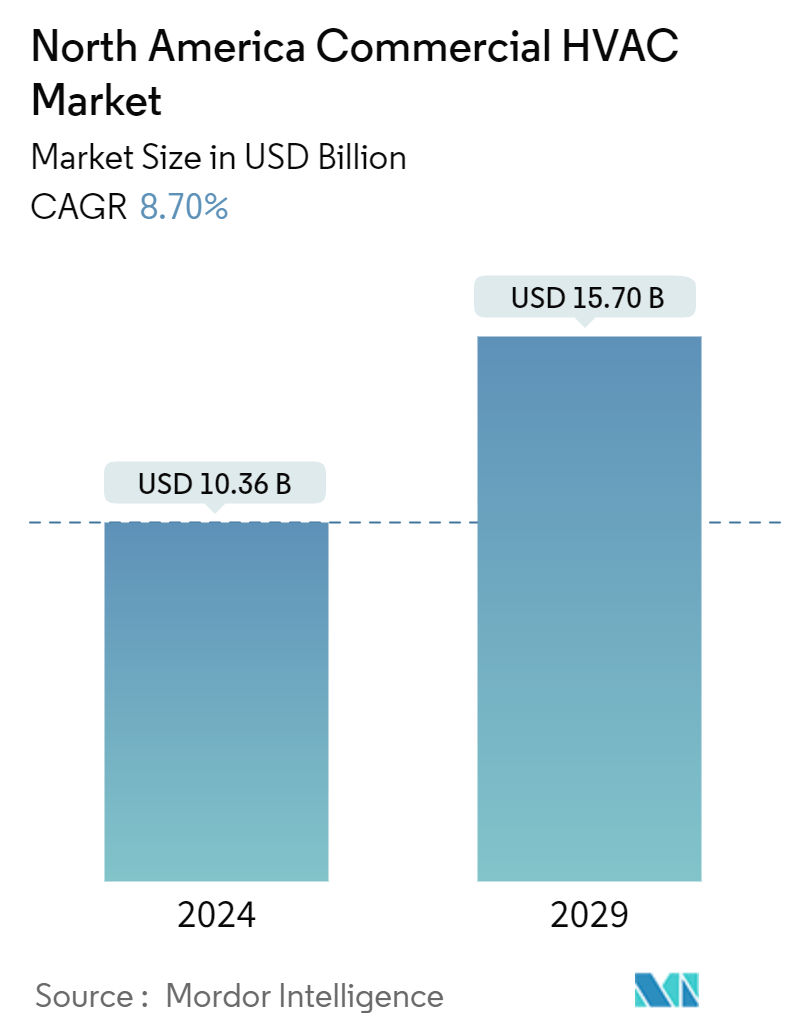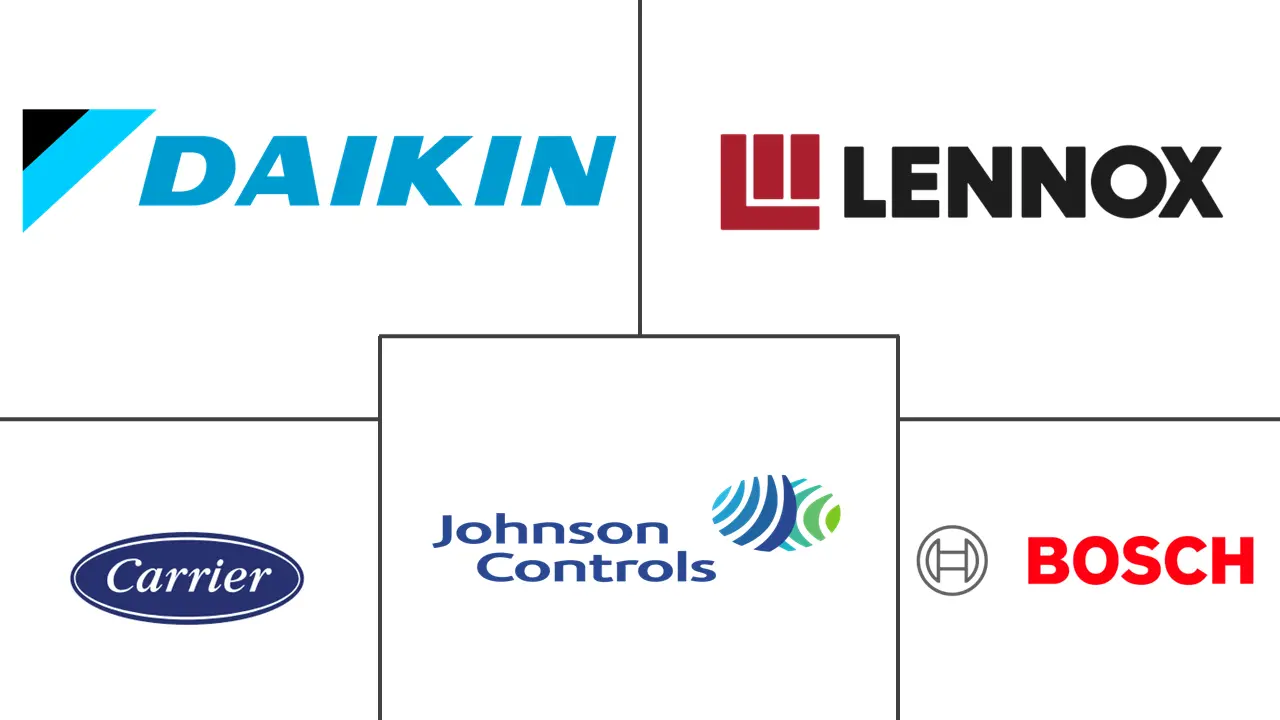Market Size of North America Commercial HVAC Industry

| Study Period | 2024 - 2029 |
| Base Year For Estimation | 2023 |
| Market Size (2024) | USD 10.36 Billion |
| Market Size (2029) | USD 15.70 Billion |
| CAGR (2024 - 2029) | 8.70 % |
| Market Concentration | Low |
Major Players
*Disclaimer: Major Players sorted in no particular order |
North America Commercial HVAC Market Analysis
The North America Commercial HVAC Market size is estimated at USD 10.36 billion in 2024, and is expected to reach USD 15.70 billion by 2029, growing at a CAGR of 8.70% during the forecast period (2024-2029).
- Large volumes of greenhouse gas emissions are produced because a lot of buildings, including homes, workplaces, schools, and factories, still rely primarily on fossil fuels, mainly natural gas, for heating. Furthermore, the current energy crisis suggests that switching to more economical, dependable, and environment-friendly building heating methods is urgently needed. In this regard, one of the most important technologies to make heating more sustainable and safe is heat pumps, which can effectively heat buildings and, thus, support market growth.
- Furthermore, the region's growing need for office space, harsh weather patterns, and rising office building activity are some of the other factors propelling the market's growth. Another important factor propelling the North American commercial HVAC industry is the growing need for energy-efficient systems. Growing environmental consciousness has led to a preference shift toward environment-friendly technology, which is driving this industry's expansion.
- The continuous initiative by the government to adopt the HVAC system is expected to fuel market growth. For instance, in November 2023, the Biden administration's initiative to enhance the adoption of electric heat pumps and decrease the dependency on fossil fuels involves a substantial investment of USD 169 million by the US Department of Energy. This funding will be utilized to facilitate the expansion of manufacturing facilities for heat pumps, as well as the production of crucial components like compressors and refrigerants. Such increasing investments by government agencies are expected to drive the demand for heat pumps.
- Furthermore, in November 2023, the government of Canada announced an investment of CAD 384 million (USD 280.65 million) to support retrofits to the Carnegie Building in Saint John. This investment will contribute to improving the heating, ventilation, and air conditioning system in the Carnegie Building and implementing the highest efficiency LED lighting, which is estimated to result in significant energy savings for the cultural heritage of the town. This improvement is expected to reduce the facility's energy consumption by an estimated 56.9% and greenhouse gas emissions by 43.8 tonnes per year.
- Some of the advances in heating, ventilation, and air conditioning systems have become known to most commercial property owners and managers. The latest technologies are taken into account when new buildings are being built or planned.
- The increasing energy prices worldwide make energy-efficient HVAC systems attractive for cost savings. Despite the potential benefits, the initial expenses of installing these systems could limit their widespread use and hinder market expansion.
- The prolonged conflict between Russia and Ukraine is also anticipated to have a big effect on the electronics sector. The conflict may result in additional disruptions and impact semiconductor supply chains, driving up the cost of electronics even further. It is anticipated that the conflict will have a substantial overall effect on the electronics sector. This would make it more difficult to produce HVAC equipment.
North America Commercial HVAC Industry Segmentation
The study tracks the revenue accrued through the sale of commercial HVAC equipment and services by various players in the North American market. The study also tracks the key market parameters, underlying growth influencers, and major vendors operating in the industry, which supports the market estimations and growth rates over the forecast period. The report’s scope encompasses market sizing and forecasts for the various market segments.
The North American commercial HVAC market is segmented by type of component (HVAC equipment [heating equipment, air conditioning/ventilation equipment] and HVAC services), end-user (hospitality, commercial buildings, public building, and other end-user industries), and country (United States and Canada). The market sizes and forecasts are provided in terms of value (USD) for all the above segments.
| By Type of Component | ||||
| ||||
| HVAC Services |
| By End-user Industry | |
| Hospitality | |
| Commercial Buildings | |
| Public Buildings | |
| Other End-user Industries |
| By Country | |
| United States | |
| Canada |
North America Commercial HVAC Market Size Summary
The North American commercial HVAC market is poised for significant growth, driven by the increasing demand for energy-efficient and environmentally friendly heating, ventilation, and air conditioning systems. The shift towards sustainable technologies, such as heat pumps, is gaining momentum due to rising energy prices and the urgent need to reduce greenhouse gas emissions from buildings that still rely on fossil fuels. The market is further bolstered by government initiatives and investments aimed at enhancing the adoption of electric heat pumps and reducing dependency on traditional energy sources. These efforts are supported by substantial funding from government agencies in both the United States and Canada, which are focused on expanding manufacturing capabilities and improving energy efficiency in commercial buildings.
The market landscape is characterized by a fragmented and competitive environment, with several prominent players like Carrier Corporation, Daikin Industries Ltd, and Johnson Controls International PLC actively expanding their market presence through strategic partnerships and collaborations. These companies are investing in innovative HVAC solutions that cater to the growing demand for sustainable and energy-efficient systems in commercial settings. The ongoing expansion of office buildings and the increasing focus on retrofitting existing structures with advanced HVAC technologies are expected to further drive market growth. Additionally, regulatory frameworks and standards, such as those set by Energy Star and the US Department of Energy, are influencing the adoption of high-efficiency equipment, thereby supporting the market's upward trajectory.
North America Commercial HVAC Market Size - Table of Contents
-
1. MARKET INSIGHTS
-
1.1 Market Overview
-
1.2 Industry Attractiveness - Porter's Five Forces Analysis
-
1.2.1 Bargaining Power of Suppliers
-
1.2.2 Bargaining Power of Consumers
-
1.2.3 Threat of New Entrants
-
1.2.4 Threat of Substitute Products
-
1.2.5 Intensity of Competitive Rivalry
-
-
1.3 Industry Value Chain Analysis
-
1.4 Impact of COVID-19 Aftereffects and Other Macroeconomic Factors on the Market
-
-
2. MARKET SEGMENTATION
-
2.1 By Type of Component
-
2.1.1 HVAC Equipment
-
2.1.1.1 Heating Equipment
-
2.1.1.2 Air Conditioning /Ventillation Equipment
-
-
2.1.2 HVAC Services
-
-
2.2 By End-user Industry
-
2.2.1 Hospitality
-
2.2.2 Commercial Buildings
-
2.2.3 Public Buildings
-
2.2.4 Other End-user Industries
-
-
2.3 By Country
-
2.3.1 United States
-
2.3.2 Canada
-
-
North America Commercial HVAC Market Size FAQs
How big is the North America Commercial HVAC Market?
The North America Commercial HVAC Market size is expected to reach USD 10.36 billion in 2024 and grow at a CAGR of 8.70% to reach USD 15.70 billion by 2029.
What is the current North America Commercial HVAC Market size?
In 2024, the North America Commercial HVAC Market size is expected to reach USD 10.36 billion.

